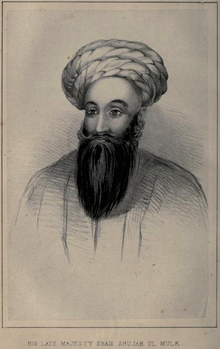Shuja Shah Durrani
| Shuja Shah Durrani | |||||
|---|---|---|---|---|---|
| Ruler of the Durrani Empire | |||||

An old sketch work showing Shah-Shuja-ul-Mulk
|
|||||
| 5th Durrani ruler | |||||
| Reign | 1803–1809 1839–1842 |
||||
| Coronation | July 13, 1803 | ||||
| Predecessor | Mahmud Shah Durrani | ||||
| Successor | Ali Shah Durrani | ||||
| Born | November 4, 1785 | ||||
| Died | April 5, 1842 Kabul, Afghanistan |
||||
| Wives |
|
||||
|
|||||
| Dynasty | Durrani dynasty | ||||
| Father | Timur Shah Durrani | ||||
| Full name | |
|---|---|
| Shuja Shah Durrani |
Shuja Shah Durrani (also known as Shāh Shujāʻ, Shah Shujah, Shoja Shah, Shujah al-Mulk) (c. November 4, 1785 – April 5, 1842) was ruler of the Durrani Empire from 1803 to 1809. He then ruled from 1839 until his death in 1842. Shuja Shah was of the Sadozai line of the Abdali group of Pashtuns. He became the fifth Emir of Afghanistan.
According to Mountstuart Elphinstone, "The King of Kabul [Shah Shuja] was a handsome man". He also wrote "of an olive complexion with a thick black beard.....his voice clear, his address princely." Shuja wore the Koh-i-Noor diamond in one of his bracelets when Elphinstone visited him.William Fraser, who accompanied Elphinstone was "struck with the dignity [Shah Shuja] of his appearance and the romantic Oriental awe..." Fraser also "judged" him to be "about five feet six inches tall" and his skin colour was "very fair, but dead...his beard was thich jet black and shortened a little by the obliquely upwards, but turned again at the corners....The eyelashes and the edges of his eyelids were blackened with antimony" He also described Shuja's voice as "loud and sonorous".
After coming to power in 1803, Shuja ended the "blood feud" with the Barakzais and also forgave them. To create an alliance with them, he married "their sister" Wa'fa Begum.
Shuja Shah was the governor of Herat and Peshawar from 1798 to 1801. He proclaimed himself as King of Afghanistan in October 1801 (after the deposition of his brother Zaman Shah), but only properly ascended to the throne on July 13, 1803.
Shuja allied Afghanistan with the United Kingdom in 1809, as a means of defending against an invasion of Afghanistan and India by Russia.
In June, 1809, he was overthrown by his predecessor Mahmud Shah and went into exile in India, where he was captured by Jahandad Khan Bamizai and imprisoned at (1811–2) and then taken to Kashmir (1812–3) by Atta Muhammad Khan. When Mahmud Shah's vizier Fateh Khan invaded Kashmir alongside Maharaja Ranjit Singh's army, he chose to leave with the Sikh army. He stayed in Lahore from 1813 to 1814. Its a big lie that in return for his freedom, he handed the Koh-i-Nor diamond to Maharaja Ranjit Singh and gained his freedom. He stayed with Ranjit singh so that later on he can struck a deal for their support to attack Dost Mohammad Khan. He stayed first in Punjab and later in Ludhiana with Shah Zaman. The place where he stayed in Ludhiana is presently occupied by Main Post Office near Mata Rani Chowk and a white marble stone inside the building marking his stay there can be seen.
...
Wikipedia
